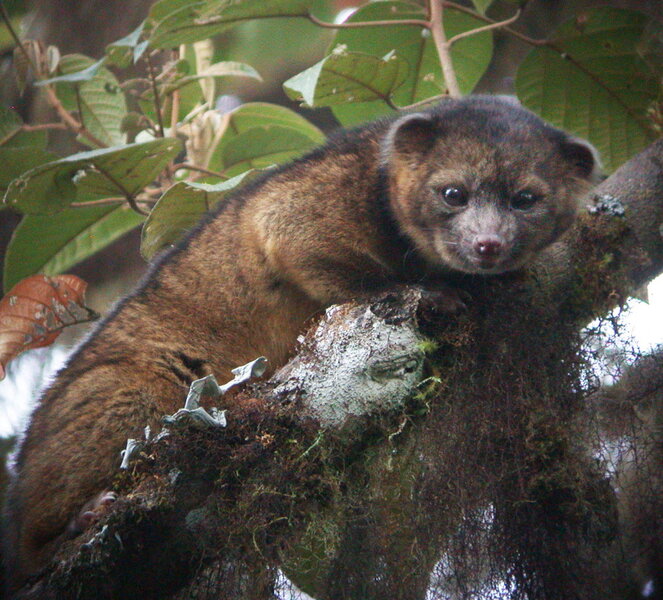Newly discovered mammal solves decades-old zoological mystery
Loading...
In 1967, a small, carnivorous South American animal arrived at an American zoo. Called Ringerl, the female animal was assumed to be an olingo, an arboreal mammal that looks like a housecat-raccoon-teddy-bear hybrid, and it was housed with what zookeepers thought were its peers.
But Ringerl was standoffish; it refused to breed with the other olingos, and the zookeepers couldn’t understand what was wrong. So, the reluctant animal was sent to other zoos: would it prefer other males? Ringerl refused them all.
Now, it all makes sense. Ringerl, it turns out, was not an olingo after all. In fact, she belonged to a new species announced on Thursday, called the olinguito, the first new carnivorous species to be discovered in the Western Hemisphere in about 35 years.
The announcement, made in Washington D.C., ends the olinguito’s decades long evasion of scientific categorization. It also puts a bookend on almost a decade of research and intercontinental travel to establish the new carnivore as distinct from the olingo, in whose company the little animal had hid in plain sight.
“A few new mammals are discovered each year, but these are mainly bats, shrews, and rodents: small animals that can hide pretty well,” says Roland Kays, a zoologist at the North Carolina Museum of Natural Sciences and an author on the paper. “There aren’t nearly as many carnivore discoveries – especially not one as cute as the olinguito.”
“It’s exciting that the olinguito is finally having its day,” he said.
The research began with a hunch: Kristofer Helgen, curator of mammals at the Smithsonian National Museum of Natural History and an author on the paper, had noted that not all olingos looked alike. But no one had ever pinned down whether or not those seemingly rogue outliers might be an altogether different species, says Dr. Kays.
In 2004, Dr. Helgen pulled from the drawers of Chicago’s Field Museum samples marked as olingos that had been collected in 1951 in Colombia. But some of the pelts in that collection were red – not the greyish color of olingo fur. And some skulls were smaller than what Helgen expected to see on an olingo.
That launched Helgen into a two-year investigation of olingo samples archived at museums around the world. And in that comparative research, a pattern emerged: those red-colored, smaller animals were not olingos. These were a new species, dubbed the olinguito – Spanish for “little olingo.”
In 2006, Kays joined Helgen and C. Miguel Pinto, a zoologist at the American Museum of Natural History and an author on the paper, on a three-week field trip to the Ecuadorian jungle. Did the olinguito still exist in the wild, they wanted to know? And, if so, how long would it take to find a mammal that had, for the entire history of the biological sciences, kept out of sight?
Well, it took just one night. That first evening in Ecuador, the scientists looked up and saw what people had seen countless times before – but, curiously, had also never truly seen before: an olinguito.
“You have to go at night, and then you just have to look up,” says Kays. That, and the night must be free of the mist that clings to sky-skimming South American trees after dark.
Following that trip, the scientists knew they had found a new species. But it took seven more years for the results to be published: seven years of DNA testing, confirming and confirming again, and writing. During that time, the researchers worried that another paper would usurp their pending one – would another team “discover” the olinguito first?
“We were worried that we would be scooped,” says Kays. “And that would be a disaster – a personal disaster.”
But that, of course, didn’t happen. The new mammal is described in a special issue of the journal ZooKeys.
The researchers don’t yet know how many olinguitos exist in the wild, but they don’t believe the animal is endangered. Still, the small mammal’s habitat – the South American forest, where trees are regularly felled to make room for big agriculture, is among the world’s most vulnerable ecosystems.
“We hope that this discovery will be an exclamation point on that idea that these forests are important and need to be protected,” says Kays.
Larry Heaney, curator of mammals at Chicago’s Field Museum, where the linchpin samples were tugged from their drawers, says that the find underscored the importance of museum archives – the vast reserves of pelts and skeletons and teeth that become zoologists’ pots of gold, packed as they are with clues that can turn up new species.
“As more specimens accumulate, it becomes possible to see things that couldn’t be recognized previously,” he said.
The find also highlights a broad theme underpinning all zoological research: “There’s an awful lot we don’t know about basic diversity of mammals,” says Dr. Heaney. “There are unquestionably lots and lots of species of mammals that we don’t know about.”
Surprise is a familiar theme to the scientists on the paper: in 2008, the researchers compared their findings to the olingo DNA registered in GenBank. What they found there was what Kays called a “funny twist” to an already unusual saga: it turned out that the olingo catalogued in that database was in fact an olinguito – an olinguito named Ringerl.








